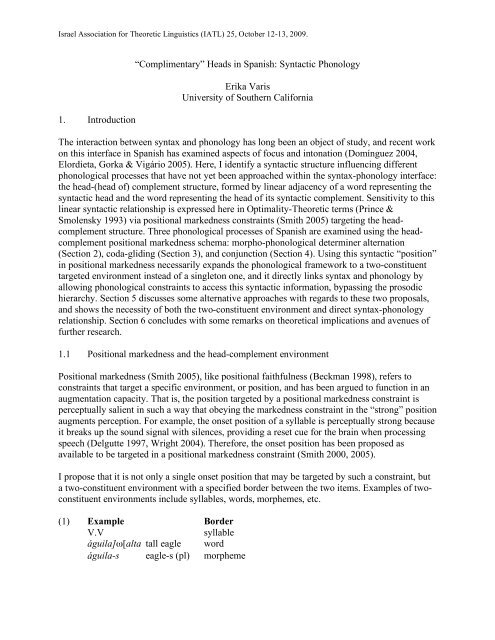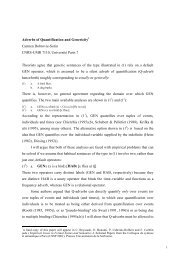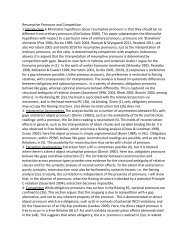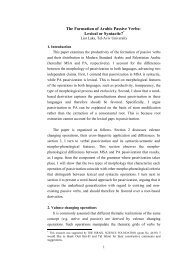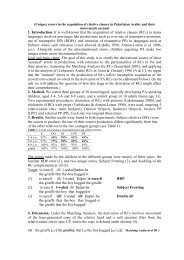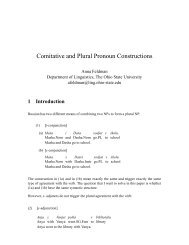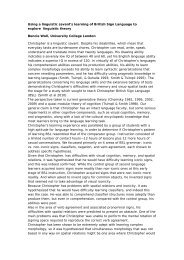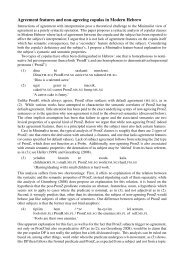paper - Generative Linguistics
paper - Generative Linguistics
paper - Generative Linguistics
You also want an ePaper? Increase the reach of your titles
YUMPU automatically turns print PDFs into web optimized ePapers that Google loves.
Israel Association for Theoretic <strong>Linguistics</strong> (IATL) 25, October 12-13, 2009.1. Introduction“Complimentary” Heads in Spanish: Syntactic PhonologyErika VarisUniversity of Southern CaliforniaThe interaction between syntax and phonology has long been an object of study, and recent workon this interface in Spanish has examined aspects of focus and intonation (Domínguez 2004,Elordieta, Gorka & Vigário 2005). Here, I identify a syntactic structure influencing differentphonological processes that have not yet been approached within the syntax-phonology interface:the head-(head of) complement structure, formed by linear adjacency of a word representing thesyntactic head and the word representing the head of its syntactic complement. Sensitivity to thislinear syntactic relationship is expressed here in Optimality-Theoretic terms (Prince &Smolensky 1993) via positional markedness constraints (Smith 2005) targeting the headcomplementstructure. Three phonological processes of Spanish are examined using the headcomplementpositional markedness schema: morpho-phonological determiner alternation(Section 2), coda-gliding (Section 3), and conjunction (Section 4). Using this syntactic “position”in positional markedness necessarily expands the phonological framework to a two-constituenttargeted environment instead of a singleton one, and it directly links syntax and phonology byallowing phonological constraints to access this syntactic information, bypassing the prosodichierarchy. Section 5 discusses some alternative approaches with regards to these two proposals,and shows the necessity of both the two-constituent environment and direct syntax-phonologyrelationship. Section 6 concludes with some remarks on theoretical implications and avenues offurther research.1.1 Positional markedness and the head-complement environmentPositional markedness (Smith 2005), like positional faithfulness (Beckman 1998), refers toconstraints that target a specific environment, or position, and has been argued to function in anaugmentation capacity. That is, the position targeted by a positional markedness constraint isperceptually salient in such a way that obeying the markedness constraint in the “strong” positionaugments perception. For example, the onset position of a syllable is perceptually strong becauseit breaks up the sound signal with silences, providing a reset cue for the brain when processingspeech (Delgutte 1997, Wright 2004). Therefore, the onset position has been proposed asavailable to be targeted in a positional markedness constraint (Smith 2000, 2005).I propose that it is not only a single onset position that may be targeted by such a constraint, buta two-constituent environment with a specified border between the two items. Examples of twoconstituentenvironments include syllables, words, morphemes, etc.(1) Example BorderV.Vsyllableáguila]ω[alta tall eagle wordáguila-s eagle-s (pl) morpheme
HoC environment, showing a sensitivity not otherwise accountable for by purely phonologicalmeans.2. Morpho-phonological determiner alternationThe Spanish feminine determiner takes the masculine form when the following noun begins withthe stressed vowel /a/ 2 , and when the determiner-noun string is uninterrupted by an adjective(stress is marked with ´).(5) Spanish determiner alternation [la]~[el]i. el águila blánca ‘the eagle[f] white[f]’[e.lá.γi.la.bláη.ka]el háda mála ‘the fairy[f] bad[f]’[e.lá.δa.má.la]el água fría ‘the water[f] cold[f]’[e.lá.γwa.frí.a]ii. la álta águila[la.ál.ta.á.γi.la]la mála háda[la.má.la.á.δa]la fría água[la.frí.a.á.γwa]‘the[f] high[f] eagle[f]’‘the[f] evil[f] fairy[f]’‘the[f] cold[f] water[f]’Previous work on the Spanish data in question (González 2003, Harris 1983, Wolf 2008)approached them from a phonological or morpho-phonological perspective, but did not addressthe syntactic data, which are crucial to manifesting the determiner alternation.The local vowel hiatus of /la-á/ must span a border between the head (the determiner) and thehead of its complement (the noun) in order to trigger the determiner alternation. An adjective inthe NP is not the head of the phrase, so the relationship between the determiner and the adjectiveis not that of head and head of complement (following Zagona 2002). Furthermore, while theadjective is posited to be in a different position of the NP depending on its postnominal (adjunct)or prenominal (specifier) linear order (Zagona 2002: p. 109-117), it is crucially never acomplement to the noun or the determiner.(6) (i) [el[águilahead blánca]NP]DP (ii) [la[álta águilahead]NP]DPDPDPD NP D NPellaNP AP AP N’águila blanca álta Náguila2 There are a few exceptions to this process, including la árabe, la Álvarez, etc. Since correspondingmasculine forms exist (el árabe, el Álvarez), I propose that these exceptions do not participate in thedeterminer alternation due to the pressure to maintain contrast (Lubowicz 2003). In addition, I assumethat the alphabetic exception la a maintains hiatus due to paradigm pressures specific to alphabetic letters.3
The differing syntactic structures affect whether the determiner switches (in 6i) or not (in 6ii). Ifollow Wolf (2008) and Salvá (1988) in analyzing the exceptional article el as morphologicallyfeminine, not masculine. Thus, there is no violation of morphological gender agreement. Theswitch is in the phonological manifestation of the determiner gender morpheme. In formulatingan OT analysis of the phenomenon, I use correspondence constraints adapted from Wolf (2008) 3to govern the morphological-phonological elements:(7) DEP-M(masculine): For every instance φ´ of the feature [masculine] at the phonological level,assign a violation-mark if there is not an instance φ of [masculine] at the morpheme level, suchthat φRφ´.Informally, DEP-M(masculine) prohibits insertion of the masculine phonological form withoutthe masculine morpheme.(8) MAX-M(feminine): For every instance φ of the feature [feminine] at the morpheme level,assign a violation-mark if there is not an instance φ´ of [feminine] at the phonological level, suchthat φRφ´.Informally, MAX-M(feminine) prohibits deletion of the feminine phonological form when there isa feminine morpheme.Both of the above constraints are violated by the la to el switch in Spanish.Focusing on the targeted environment of the switch, I use the positional markedness constraintNO HIATUS(HoC), as defined in (4), to produce alternation blocking by an adjective 4 .(9) Tableau: determiner alternation(i) la águila alta NO HIATUS(HoC) DEP-M(masc) MAX-M(fem) NO HIATUSa. la águila álta *! **→b. el águila álta * * *(ii) la alta águila→a. la álta águila **b. el álta águila *! *! *In candidate (9ia) there is an unwanted hiatus vowel sequence across an HoC boundary.Candidate (9ib) repairs hiatus at the expense of DEP-M(masculine) and MAX-M(feminine) bydeleting the feminine determiner and inserting the masculine one. Candidate (9iia) also includesan unwanted hiatus vowel sequence [a-á], but it is not across an HoC boundary, and therefore3 For the purpose of this study, I simply refer to the morpheme level and the phonological level in theseconstraints. Wolf (2008) uses a more complex “morph” concept to refer to the phonological elements thatare linked with the morpheme in the input.4 For the purposes of focusing on the syntactic element of this phenomenon, I am leaving the aspects ofvowel quality and stress, which are also clearly active, as a separate issue. One way of addressing thesituation includes the use of Dispersion Theoretic-type minimum distance constraints on adjacent vowels(Casali 1998, Flemming 1995), and positional markedness targeting stressed vowels (Smith 2005).4
vacuously satisfies the positional markedness constraint. Candidate (9iib) unnecessarily repairsthe vowel hiatus, and is ruled out by morpho-phonological faithfulness.The constraint ranking falls into the positional markedness schema presented in Smith (2005):(10) Positional Markedness >> Faith >> MarkednessNO HIATUS (HoC) >> DEP-M(masc), MAX-M(fem) >> NO HIATUS3. Coda glidingIn Caribbean dialects of Spanish, coda consonants show various weakening effects, including /s/aspiration or deletion and /n/ velarization. In Cibaeño, a Dominican dialect, laterals and rhoticsoptionally form palatal glides in coda position (11i). But, there are exceptions when thefollowing word is vowel-initial (Guitart 1981, Harris 1983) (11ii):(11) Coda glidingi. papel blanco<strong>paper</strong> whiteél dahe givesel díathe day= pape[j] blanco ii. papel azul<strong>paper</strong> blue= é[j] da él avisahe warns= e[j] día el avisothe warning= pape[j] azul= é[j] avisa= e[l] avisoThe one context that resists coda gliding is the vowel-initial determiner-noun environment. Thehead-complement relationship of el aviso (12iii) stands in contrast to the head-adjunct andspecifier-head relationship in papel azul (12i) and él avisa (12ii), respectively: 5(12) i. pape[j] azul ii. é[j] avisa iii. e[l] avisoNP VP DPNP AP Spec V’ D NPé[j]elpape[j] azúl V avisoavisaOnce again, the avoidance of a marked sequence (this time, glide-vowel) 6 across an HoCboundary affects the phonological pattern, this time blocking coda weakening.In order to focus on the role of the syntactic component, I use the cover markedness constraintsSEGMENT SEQUENCING and CODA LENITION in the OT analysis, which are descriptive of the5 Unfortunately, there was no data presented with an adjective intervening between the determiner andnoun, so it is unclear whether the appropriate specification is head-head of complement specification, ormerely a simpler head-complement one.6 Many linguists have made use of a consonant-vowel sequence scale, often couched in terms of an idealonset (Smith 2005, Prince & Smolensky 1993), with voiceless obstruents at the “best” end of thespectrum and glides/semi-vowels at the “worst”.5
equirements driving the phonological process:(13) SEGSEQ: enforces perceptually salient consonant-vowel sequences (in this case, it acts as*Glide-Vowel) 7CODALENITION: reduces or weakens coda consonants in various ways, here by reducingliquids to glides.The positional markedness constraint active here is:(14) SEGSEQ(HoC): prohibits G-V across an HoC boundary.The following tableau demonstrates the constraint interaction of positional markedness SEGSEQtogether with its regular markedness version and the constraint driving coda lenition.(15) Tableau: coda gliding(i) el spec avisa head SEGSEQ(HoC) CODALEN SEGSEQa. e[l] avisa *!→b. e[j] avisa *(ii) el head aviso comp→a. e[l] aviso *b. e[j] aviso *! *Candidate (15ia) vacuously satisfies SEGSEQ(HoC) because it does not include an HoCboundary, but is ruled out by CODALEN, because it fails to glide the liquid. Candidate (15ib) alsovacuously satisfies SEGSEQ(HoC), and wins on CODALEN. Candidate (15iia) obeysSEGSEQ(HOC), though it fails to lenite the coda consonant, and candidate (15iib) glides the codato obey CODALEN, but violates SEGSEQ(HOC) by including the unwanted sequence G-V across ahead-head of complement boundary.In this case, the positional markedness and general markedness constraints do not surround aFaith constraint, but rather another markedness, because HoC prevents an otherwise widespreadmarkedness repair 8 . Aside from this minor change, the general ranking schema remains thesame:(16) SEGSEQ (HoC) >> CODALEN >> SEGSEQ4. ConjunctionConjunction is another area of the phonological grammar where the head-complement syntactic7 IDENT-IO must also be low-ranked in this dialect, to produce the liquid → glide effect.8 This effect could also be obtained by using the HoC environment with a positional faithfulnessconstraint, perhaps something like IDENT(HoC). I prefer to use positional markedness here to reflect thesimilarities between determiner alternation, coda gliding and conjunction. All three cases involve amarked sequence of segments, whether vowel-vowel or glide-vowel, and the avoidance of said markedsequence in the head-complement environment.6
structure plays a role. In Spanish, the two coordinators ‘and’ and ‘or’ consist of a single vowelwhose allophone surfaces when followed by a word beginning with the same vowel. However,the alternation does not occur with identical vowels between the first conjunct and thecoordinator, because they are not in a head-complement relation.(17) i. inteligente [i] sincero ii. sincero [e] inteligenteintelligent and sinceresincere and intelligentuno [o] dosone or twouno [u] otroone or (the) otherIn (17i), we see the standard phonological realization of the coordinator morpheme, whenfollowed by any consonant. But in (17ii), word [i] ‘and’ realizes as [e] when followed by an i-initial word, and [o] ‘or’ realizes as [u] when followed by an o-initial word. It is notable that inthe phrase uno o dos, even though there is an identical o-o sequence between the words uno ando, the allophone [u] is not triggered. I propose that this difference stems from the lack of headcomplementrelation between uno and o, whereas there is a head-complement relation between/o/ and otro in the phrase uno u otro. The syntactic structure for uno u otro is given in (18),following Camacho (2003).(18) CoordPConj1unoCoorduCoord’Conj2otroUnlike the previous case studies, where the HoC environment was specific to the head of thecomplement, with conjunction it appears to be more general, and sensitive only to the headcomplementrelationship. In structures with complex second conjuncts, allophonic variation willstill be triggered by a non-head member of the conjunct 9 :(19) amplios espacios e increibles paisajes wide spaces and incredible landscapesaltas torres e invencibles murallas tall towers and invincible wallscrueles invasores u orgullosos patriotas cruel invaders or proud patriotsaudaces marineros u osados guerreros brave sailors or daring warriorsWhile the head of the complement does not affect the process here, the dichotomy betweencomplement (allophony triggered) and non-complement (allophony not triggered) still holds, so I9 Many thanks to the attendees of IATL 25 for pointing out this possibility, and to Hector Velásquez forproviding the examples in (19). Attempts to form counterexamples with intervening sentential adverbsfailed, as the adverb was always interpreted to be within the 2 nd conjunct, instead of applying to the 1 stconjunct as well. Truly parenthetical sentential adverbs in this position were produced with pauses,allowing maintenance of the i-i or o-o vowel hiatus. Further exploration of such prosodic effects isneeded.7
use the positional markedness environment head-complement (HC), which allows for the moregeneral sensitivity:(20) NO HIATUS (HC): Prohibition against adjacent vowels across a head-complementboundary 10In the tableau (21), we can see the interaction between this HC positional markedness andfaithfulness, here in the form of IDENT[hi]-IO.(21) Tableau: conjunction(i) uno/o.o/tro NO HIATUS(HC) IDENT [hi]-IO NO HIATUSa. uno[o.o]tro *! **→b. uno[u.o]tro * *(ii) un/o.o/dos→a. un[o.o]dos *b. un[u.o]dos *!Candidate (21ia) contains an unwanted identical vowel sequence across an HC boundary, and isruled out. Candidate (21ib) repairs the vowel sequence by changing the coordinator to [u],incurring a violation of IDENT [hi]-IO, but obeying NO HIATUS(HC). Candidate (21iia) alsocontains the unwanted identical vowel sequence, but it is between the specifier and head, nothead and complement, so it vacuously satisfies NO HIATUS(HC). Candidate (21iib) unnecessarilyrepairs the vowel sequence and incurs a violation of IDENT [hi]-IO, which rules it out.The by now familiar ranking of positional markedness over faithfulness over general markednessis maintained, with the slight alteration in the position (HC):(22) NO HIATUS (HC) >> IDENT [hi]-IO >> NO HIATUS5. Alternative analysesThe case studies above demonstrate interaction between syntax and phonology via phonologicalmarkedness sensitivity to the head-complement relationship. The syntactic relationship iscouched in terms of an environment for positional markedness constraints, expanding thepositional markedness framework to two-constituent environments. The targeted positionreferences a two-word window, allowing the interword syntactic relationship to come into play,rather than focusing on a single category that is blind to the surrounding context. The HoCpositional markedness approach presented here also proposes a direct link between syntax andphonology, bypassing the prosodic hierarchy which has previously been proposed to be anecessary mediator. This section evaluates alternative analyses which avoid double constituentenvironments or a direct link between syntax and phonology, but which ultimately fail to accountfor the data in question.10 Again, I leave the identical vowel quality as a separate issue, though both NO HIATUS constraints heremust be sensitive to the difference between the sequences u-o and o-o. It is also worth mentioning thatstress does not play a role in this phenomenon, unlike determiner alternation.8
5.1 One constituent environment vs. twoPreviously established positional markedness constraints targeted environments makingreference to a single constituent, such as the onset of a syllable (Smith 2005). Considering thesimilar effects of NO HIATUS and ONSET, why not simply use ONSET-based positionalmarkedness to explain the data?ONSET may be formed in a couple of different ways in attempting to explain the determineralternation in Spanish. First, we might use positional ONSET(noun), enforcing an onset at thebeginning of every noun. This would drive alternation from /la/ águila to [el] águila, but doesnot differentiate between the phrases la álta águila and el águila. In the determiner-adjectivenouncontext, the a-initial noun águila does not have an onset, despite still being a noun andtherefore eligible for the above suggested positional markedness ONSET constraint.An additional advantage of the NO HIATUS two-constituent environment is that it allows futuredetailed analysis of vowel quality in this phenomenon. As previously mentioned, the initialvowel quality of the noun will affect whether or not the determiner alternation is triggered. Forexample, la hora [la óra] ‘the hour’ maintains the feminine form of the determiner; non-identicalvowel quality satisfies markedness. A one-constituent constraint like ONSET does not leave roomfor analysis of vowel quality, since it can only focus on one vowel, not two. The alternation istriggered only with identical vowels, a-a, i-i, or o-o, in both the determiner and conjunction data.A two-constituent constraint like NO HIATUS allows for future formulations sensitive to thisadjacent vowel quality.Furthermore, since adjectives in Spanish have both masculine and feminine forms, were we touse a constraint like ONSET(noun), the unattested masculine form alto would be available as anon-identical vowel hiatus in the phrase la álta águila, predicting la álto águila. This candidatewould completely satisfy ONSET(noun), once vowel quality blocking effects were taken intoaccount.(23) Tableau: hypothetical Onset(noun) in determiner alternation, with vowel qualityi. la águila Onset(noun) DEP-M(masc) MAX-M(fem) Onseta. la águila *! *→ b. el águila * *ii. la hora→ a. la hora *b. el hora *! *!iii. la álta águilaa. la álta águila *! **b. el álta águila *! * * c. la álto águila * * **An ONSET formulation would have further trouble with conjunction. The combination of thecoordinator and 2 nd conjunct will always trigger the vowel alternation, regardless of the syntacticcategory of the 2 nd conjunct:9
(24) N: uno u otro ‘one or the other’A: sincero e inteligente ‘sincere and intelligent’DP: María e Isabel ‘Maria and Isabel’V: destaca e intensifica ‘[it] emphasizes and intensifies’The second word of the two-constituent environment varies, but in all cases the syntacticrelationship between the two words remains the same: head-complement.5.2 Phrasal phonology vs. direct linkThe three phenomena shown here provide support for the syntactic head-complement relation astargeted by phonology. Previous work has argued for the accessibility of syntax to thephonological grammar (Chen 1990), but a direct relation between syntax and phonology has alsobeen strongly argued against in literature on Phrasal Phonology (Nespor & Vogel 1986, Inkelas& Zec 1990), where the prosodic hierarchy has been posited as a necessary intermediate betweensyntax and phonology. So, how does prosody fare with the phenomena?Taking a look at the morpho-phonological determiner switch, the data show sensitivity to theword orders DN and DA. Therefore, in order for prosody to mediate between syntax andphonology, it must produce a difference between the word orders: DNA vs. DAN.There are a few problems with this proposed prosodic difference. Recent work on Italian (Dehé& Samek-Ludovici 2009) showed no statistically significant differences in the prosodic patternsof NA and AN sequences, with a preceding indefinite article. Regardless of word order, thesequence was wrapped in a single phonological phrase. Also, I performed pilot recordings inSpanish with the DNA and DAN sequences, which consistently displayed a pitch accent (used inprevious Spanish prosodic literature as an indication of a phonological phrase boundary [Prieto2006]) on the last word of the sequence. There was no p-phrase boundary anywhere in betweenany of the words in question. This lack of evidence indicates that if there is a prosodic structuredifference, it is not experimentally measurable on the p-phrase level.There is, of course, the possibility that there is an underlying phrasal hierarchical difference thatmaps onto the same prosodic outcome. Beneath the p-phrase, there are different possiblestructures for the words in question. Following Anderson (2005) and Selkirk (1996), thedeterminer prosodifies as a clitic, but there are different types of clitics:(25i) Internal clitic (25ii) Affixal cliticP-PhraseP-PhrasePrWdP-WdClitic Host P-WdCliticHost10
(25iii) Free clitic (25iv) Prosodic Word cliticP-PhraseP-PhrasePrWd PrWd PrWdClitic Host Clitic HostIn Spanish, the determiner is not a prosodic word, and it does not receive lexical stress, whichrules out the prosodic word clitic structure in (25iv). The internal clitic and affixal cliticstructures have been proposed mainly to show the difference between enclisis and proclisis,respectively. Spanish has enclisis and proclisis with other clitics, but the determiner showssimilarity to the proclitic structure of accusative pronoun clitics (Uriagereka 1995), and theSpanish determiner (and indeed, other clitics) shows no classic PrWd-level phenomena, such asstress assignment. These observations lead us towards an affixal or free clitic structure, ratherthan an internal (enclitic) structure, leaving the free clitic and affixal clitic as the two possibleprosodic structures we’re looking for to distinguish between the behavior of the determiner inDNA and DAN.Let’s assume DN is affixal but DA is free, and the determiner simply varies in its clitic structure.Of course, when we add the second element of the NP, we have to posit a p-phrase boundary inthe free clitic scenario, either between the A and N (26i), or between the D and A (26ii).(26i) Free clitic construction + PrWdPrWds[[la álta ω ] φ águila ω ] φP-PhraseP-Phrase(26ii) Free clitic construction on two[la [álta ω águila ω ] φ ] φP-PhraseP-PhrasePrWd PrWd PrWd PrWdla álta águila la álta águilaAnd, as previously discussed, there is no evidence of a p-boundary between either word pairs.A second problem with phrasal phonology is it has been posited to be blind to syntactic category(Nespor & Vogel 1986), which would mean that there is no reason for the determiner toprosodify with one structure when followed by a noun, but another structure when followed byan adjective.As a result of these two problems, both constructions must be of the affixal clitic type, in order toavoid an intervening p-phrase boundary and follow overall phrasal theory.11
(27) Affixal clitic construction + additional PrWd(i) [[la álta] ω [águila] ω ] φ (ii) [[el águila] ω [álta] ω ] φP-PhraseP-PhrasePrWd PrWd PrWd PrWdClitic PrWd Clitic PrWdla álta águila el águila áltaProsodic hierarchy cannot produce a difference between the word orders, and therefore isinadequate as a mediator between syntax and phonology for this phenomenon. Syntax andphonology are directly connected, such that the phonological grammar has access to syntacticdata 11 .6.0 ConclusionIn sum, we have seen three different phonological processes in Spanish—and its dialects—thatare sensitive to the head-(head of)complement syntactic structure in boundary augmentation.Determiner alternation augments a V-V sequence to C-V only when identical vowel hiatusoccurs across a head-head of complement boundary: between a determiner and noun, notdeterminer and adjective or noun and adjective. Coda gliding in Cibaeño is blocked, augmentingsegment sequencing by maintaining C-V over G-V, also only between determiners and nouns. Inconjunction, identical vowel hiatus between the coordinator and 2 nd conjunct triggers the vocalicchange of the coordinator so that the V-V sequence is non-identical, but hiatus between the 1 stconjunct and coordinator has no effect.The HoC or HC environment sensitivity is expressed as positional markedness, following Smith(2005), targeting the syntactic environment, and in these phenomena manifests with segmentsequencing markedness constraints. Constraint interaction in general follows the positionalmarkedness layout: C(HOC) >> FAITH >> C. The positional markedness framework presented inSmith’s work is expanded here to a double-constituent environment combined with a NOHIATUS-type constraint base, as the most effective and representative of this data. The use ofpositional markedness here has also allowed a direct link between phonology and syntax,contrary to current phrasal phonological theory.Two main implications for phonological theory result from the head-complement explorationpresented here. One is that at least one language of the world exhibits a direct influence of syntaxon phonology, without reference to prosodic hierarchy, challenging the universal necessity ofphrasal phonology as a mediator, which suggests future changes or reworking of the theoreticalframework. The second implication is that of the “specialness” of the head-complement relation.The fact that this syntactic relationship is targeted implies that it is special to the grammar insome way. While the head-adjunct and spec-head relations have been identified in syntax as11 Note that in this is not a two-way influence. Like Chen (1990), phonology is affected by syntax, butsyntax is not affected by phonology.12
having special or distinctive properties (Chen 1990 and Koopman 2006, respectively), it seemsthat little has been proposed for the head-complement relation, as of yet. More research in syntaxand phonology is needed to further explore the HoC relation and provide an explanation for whythis environment stands out from the rest in the syntax-phonology interface.ReferencesAnderson, Stephen R. 2005. Aspects of the Theory of Clitics. Oxford Studies in Theoretical<strong>Linguistics</strong>. Oxford University Press.Beckman, Jill, 1998. Positional Faithfulness. University of Massachusetts, Amherst: dissertation.ROA-234.Camacho, Jose. 2003. The structure of coordination: conjunction and agreement phenomena inSpanish and other languages. Kluwer Academic Publishers.Casali, Roderic F. 1998. Resolving Hiatus. Outstanding dissertations in <strong>Linguistics</strong>. GarlandPublishing, Inc., New York.Chen, Matthew Y. 1990. What must phonology know about syntax? In Sharon Inkelas & DragaZec (eds.) The Phonology Syntax Connection. University of Chicago Press.Chomsky, Noam. 1970. Remarks on nominalization. In R. Jacobs and P. Rosenbaum (eds.)Reading in English Transformational Grammar, 184-221. Waltham: Ginn.Dehé, Nicole & Vieri Samek-Ludovici. 2009. On the prosody and syntax of DPs: evidence fromItalian noun-adjective sequences. Natural Language Linguistic Theory 27: 45-75.Delgutte, Bertrand. 1997. Auditory Neural Processing of Speech, in W.J. Hardcastle and J. Laver(eds.) The Handbook of Phonetic Sciences. Oxford: Blackwell, 507-538.Domínguez, Laura. 2004. Mapping Focus: The syntax and prosody of focus in Spanish. BostonUniversity, Boston, MA: dissertation.Elordieta, Gorka, Sónia Frota and Marina Vigário. 2005. Subjects, objects and intonationalphrasing in Spnaish and Portuguese. Studia Linguistica 59: 11-143.Flemming, Edward. 1995. Auditory representations in phonology. UCLA: Ph.D. dissertation.González, Carolina. 2003. Interacción fonológico–morfológica de los artículos definidos enespañol e italiano. In Fernando Sánchez Miret (ed.), Actas del XXIII Congreso Internacionalde Lingüística y Filología Románica, Salamanca, 24-30 septiembre 2001, vol. I. Tübingen:Max Niemeyer Verlag, 343-355.Guitart, Jorge M. 1981. Some theoretical implications of liquid gliding in Cibaeño DominicanSpanish. In H. Contreras and J. Klausenberger (eds.) Proceedings of the Tenth AnniversarySymposium on Romance <strong>Linguistics</strong>, supplement II to Papers in <strong>Linguistics</strong> 223-228.Washington: University of Washington.Harris, James W. 1983. Syllable Structure and Stress in Spanish: A Nonlinear Analysis.Linguistic Inquiry Monographs 8: 1-158. Cambridge, MA.Inkelas, Sharon and Draga Zec. 1990. The Phonology Syntax Connection. University of ChicagoPress.Koopman, Hilda. 2006. Agreement configurations: in defense of “Spec head”. In C. Boeckx (ed.)Agreement Systems. John Benjamins.Lubowicz, Anna. 2003. Contrast Preservation in Phonological Mappings. Ph.D. dissertation,University of Massachusetts, Amherst. GLSA Publishing. ROA-554.13
McCarthy, John J. 1993. A Case of Surface Constraint Violation. Constraint-Based Theories inMultilinear Phonology, Carole Paradis and Darlene LaCharité (eds.), special issue ofCanadian Journal of <strong>Linguistics</strong> 38: 169-195.Nespor, Marina and Irene Vogel. 1986. Prosodic Phonology. Dortrecht: Foris Publications.Prieto, Pilar. 2006. Phonological phrasing in Spanish. In Fernando Martínez-Gil and SoniaColina (eds.) Optimality-Theoretic Studies in Spanish Phonology. John Benjamins PublishingCompany.Prince, Alan and Paul Smolensky. 1993. Optimality Theory: Constraint Interaction in <strong>Generative</strong>Grammar. Rutgers University Center for Cognitive Science Technical Report 2. ROA-537-0802.Salvá, Vicente. 1988. Gramática de la Lengua Castellana, según ahora se habla. Estudio yedición de Margarita Lliteras. Vol. I. Editorial Arco Libros, S.A., Madrid.Selkirk, Elisabeth. 1996. The prosodic structure of function words. In James L. Morgan &Katharine Demuth (eds.) Signal to Syntax: bootstrapping from speech to grammar in earlyacquisition. Lawrence Earlbaum Associates, Inc.Smith, Jennifer L. 2000. Prominence, augmentation and neutralization in phonology. In LisaConathan, Jeff Good, Darya Kavitskaya, Alyssa Wulf and Alan Yu (eds.) Berkeley<strong>Linguistics</strong> Society 26: 247-257.Smith, Jennifer L. 2005. Phonological Augmentation in Prominent Positions. OutstandingDissertations in <strong>Linguistics</strong>. Routledge, New York.Uriagereka, Juan. 1995. Aspects of the syntax of clitic placement in Western Romance.Linguistic Inquiry, 26: 79-123. MIT Press.Wolf, Matthew Adam. 2008. Optimal Interleaving: serial morphology-phonology interaction in aconstraint-based model. PhD dissertation: University of Massachusetts, Amherst.Wright, Richard. 2004. A review of perceptual cues and cue robustness. In Bruce Hayes, RobertKirchner and Donca Steriade (eds.) Phonetically Based Phonology, 34-57. CambridgeUniversity Press.Zagona, Karen. 2002. The Syntax of Spanish. Cambridge University Press.14


